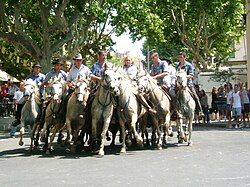
Camargue equitation (Occitan : equitacion de Camarga) is the traditional style of working equitation of the gardian herders of the Camargue region of southern France. It is closely associated with the Camargue horse, with Camargue cattle, and with the bouvino, the traditional cultural world of cattle farming in the Camargue. [1]